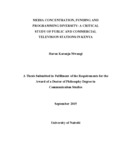| dc.description.abstract | The study investigated how media ownership and competition influences diversity of
television content. It sought to establish whether the increase in the number of television
channels in Kenya is accompanied by a similar increase in the diversity of content. In
essence, the study assessed the impact of television market structure, funding, and
conduct of media players in determining diversity of content as well as the influence of
legal and media regulatory changes. The study was informed by common observation in
Kenya’s TV market as well as similar studies elsewhere that concentration of media
ownership and attendant competition between them has compelled the broadcasters to be
more business-like, producing more market-led programmes of drama and soap opera and
resorting to increased imitation, duplication and homogenisation of programmes. Thus
the increase in the number of TV players many not necessarily result in increased
diversity of television content for viewers. Using structure conduct and performance
economic model as a framework of analysis, and employing critical political economy of
the media to underpin theoretical discussions, this study examined diversity performance
of the free to air, advertisement-supported TV stations, both commercial and public
service broadcasters (PSB) in Kenya. The study was carried among the five leading TV
stations in Kenya in terms of audience market share, namely Citizen TV (CTV), Kenya
Television Network (KTN), Nation TV (NTV), K24 and state run Kenya Broadcasting
Corporation (KBC). It analysed programme schedules and reviewed literature on the
Kenyan TV industry, media laws and regulations. It used primary data from media
executives to understand the conduct and behaviour of stations with specific focus on
programming. The study found out that the TV market in Kenya is pluralistic,
competitive and unconcentrated. This has compelled the broadcasters to produce more
market-led programmes of drama, film and soap operas and resorted to increased
imitation, duplication and homogenisation of programmes. While the absolute number of
programmes that viewers could choose from have increased, the diversity of content
offered by Kenya’s television industry has only increased modestly. In addition, despite
its public service remit, KBC is not distinct from the private and commercial TV stations.
It focuses on entertainment content as it seeks to compete in what has become a
hypercommercialised media environment. Thus the commercialisation of the KBC and
the increased control of public television by private media have led to the decline of
serious and ‘informative’ current affairs content in preference for more entertainment
programming. In essence, this study reveals that despite the proliferation of television
station in Kenya, the Kenyan TV industry is increasingly strangling diversity and thus
media policy and regulation should be focused on content as opposed to structure to
enhance diversity. | en_US |

